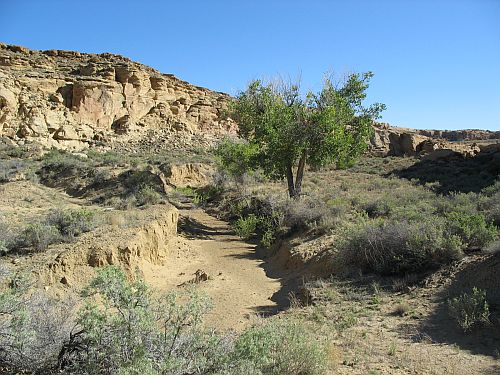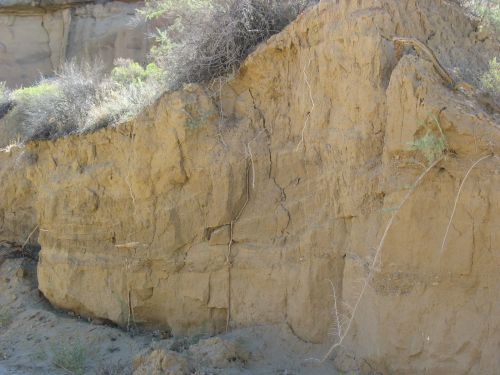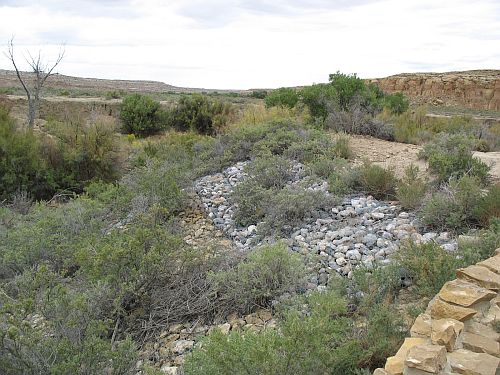
Famous Petroglyph Panel High on Cliff Wall
There are a lot of mysteries about Chaco Canyon and the system of which it seems to have been the center. Even some of the most fundamental questions about the canyon, like how many people lived there, what they were doing there, and why, remain remarkably contentious even after over a century of research. One of the major reasons for this is that, while there are a lot of obvious continuities between Chaco and the other manifestations of Puebloan society both earlier and later, including the modern Pueblos, there are also a lot of differences which make it impossible to interpret Chaco purely from other evidence internal to the culture history of the southwest. Thus, for many questions to be answered comparisons have to be made to other societies in other places and at other times.
Which societies to use as analogues for comparative purposes is a difficult issue, however. Is it better to use the closest societies either temporally or spatially that show similarities to puzzling Chacoan phenomena, even when the similarities are pretty general and ambiguous? Or is it better to look far afield, around the world and throughout time, to find situations that seem to most closely match the Chacoan one? Opinions differ, and so do the resulting comparative studies.
At this point I don’t really have an opinion on the general question of how far afield it is necessary or preferable to go in search of analogues to Chaco. I suspect that the most illuminating comparisons will ultimately turn out to be those close to Chaco along some dimension, and I think searching the whole list of human societies is bound to result in a lot of false matches that can easily be misleading, but I think with suitable caution certain aspects of better-documented faraway societies can shed some light on particular questions about Chaco.
This post is an attempt to look at Chaco through the lens of two books on very different subjects that I happen to have recently read. Although not everything that I read is directly relevant to Chaco, I spend so much of my time thinking about Chacoan issues that I have had a tendency to look at everything with those issues somewhere in the back of my mind. The nature of the unanswered questions about Chaco is such that it’s very easy to find connections to them in all sorts of things, and these may well (but, of course, won’t necessarily) shed some interesting light on them.
The books in question are The Reformation by Diarmaid MacCulloch and Ecology in Ancient Civilizations by Donald Hughes. (Hey, I said this was going far afield.) Obviously, the amount of direct relevance to Chaco in either of these books is minimal. Hughes briefly mentions the modern Pueblos at one point, and McCulloch makes some references to Spain in the New World, but that’s about as close as either gets. The more general topics they discuss, however, have a great deal of relevance to how we look at Chaco and its world.
Of the two, MacCulloch is the most tangential for my purposes. His book is a pretty broad overview of the history of the Reformation, without much detail on most specific events within that complicated history. It’s interesting reading, and remarkably balanced and sympathetic in its portrayal of both the Protestant and Catholic perspectives. MacCulloch is quite clear that he is consciously choosing to present the Reformation primarily through the lens of intellectual history, which I take to be a reaction to some recent work that has emphasized the political and economic aspects of the rise of Protestantism, especially among social elites in northern Europe. This emphasis on ideas is very explicit throughout the work, and I think it largely succeeds in showing that, whatever else was going on in these societies at the time, the ideas that formed the heart of Reformation (and Counter-Reformation) thinking were very powerful and mattered a great deal to people.

Petroglyph Panel with Complex Imagery
And this is where the relevance to Chaco comes in. Recently, there has been a notable turn in Chacoan studies from an emphasis on material, economic aspects of the Chaco system, an approach particularly identified with the (now not so) “New Archaeology” exemplified by the Chaco Project in the 1970s and 1980s, to an emphasis on more abstract, ideological aspects, which are generally taken to be “ritual” or “religious” in nature. Many younger scholars emphasize these aspects of the Chacoan system in their recent work, with some even arguing that the system was primarily ritual or ideological rather than political or economic in nature. It’s definitely possible to get a bit carried away with this sort of thinking, especially since the actual content of the rituals and ideology in question is largely inaccessible to us today, and Lynne Sebastian has sharply criticized a tendency to simply substitute ritual for political control in models of Chaco, but I think it’s pretty clear that ideology was important in some way to the Chaco system and MacCulloch’s demonstration of the powerful effects of ideas in a complicated social, political and economic transition. The Reformation is probably not particularly similar to anything about Chaco, of course (though it’s unwise to peremptorily rule out any comparisons), but it has the advantage of being much better documented, at least. While some recent models of Chacoan society may go too far in the direction of privileging the spiritual over the material, I think they are nonetheless a necessary reaction to previous models that went too far in the other direction.

Tributary Drainage in Chaco Canyon
Speaking of material factors, however, they are still very important, as Hughes points out in his book. This is one of the earliest works in the field of environmental history, so I’m sure a lot of it has been superseded by more recent work, but it’s still a very useful general overview of how various ancient civilizations interacted with their natural environments. Hughes goes through a variety of civilizations, mostly in the Near East and Mediterranean Basin, and examines both their attitudes toward nature, when these can be determined, and the effect of their activities on the environment. While he discusses Egypt, Mesopotamia, Persia, and some other early societies, his focus is primarily on Greece and Rome, and his approach is primarily textual: his data for both the attitudes and the actions comes mainly from the writings of the ancients themselves, and he uses archaeological information sparingly and mostly in regard to societies without writing.
One of the most important conclusions that leaps out of this book is that most of the societies examined had attitudes toward nature that were fairly compatible with a responsible, sustainable relationship with the environment, but that nearly all of them ended up destroying their environment anyway, either because they lacked the scientific and technological knowledge to know how to act best or because they let their values change as they became wealthier and more powerful through exploitation of natural resources. Overall, the Egyptians comes across best in terms of preserving their environment, though that may have more to do with the inherent richness of that environment than with anything they did with it, and the Romans come across worst, though the Greeks and Mesopotamians don’t look a whole lot better. The various types of ecological destruction tallied in each chapter make for depressing but important reading, particularly given the clear parallels between the most destructive societies and our own.

Entrenched Arroyo
It should be clear, I hope, that this book has a lot of general relevance, but it also has a great deal of specific relevance to thinking about Chaco, and largely for the same reasons. All those things about Mesopotamian and Roman attitudes of ownership of and dominance over nature are not only eerily similar to our own ideas, but very compatible with the sorts of things we can see the Chacoans doing with and to their environment. While the Chacoans had no writing and we cannot therefore know exactly what their attitudes were, the things they built were on an immense scale and used up enormous amounts of resources. Their buildings, roads, and other constructions were also generally designed with a great deal of abstract formality, much of it probably astronomical in nature, rather than with much concern for accommodating their ideas to their surroundings. (This is, by the way, a considerable contrast with both the ideology and the practices of the modern Pueblos.) It’s hard to say how much the Chacoans’ activities contributed to the deterioration of their environment, but there’s clear evidence that it did deteriorate and that that deterioration had at least some role in the downfall of the Chaco System.
The study of the past is interesting for its own sake (or so I think, at least), but it is also relevant to the present, though the exact nature of its relevance is not always obvious. These two books are useful in trying to understand Chaco. Trying to understand Chaco is one of the main purposes of this blog, but as the subtitle suggests, it’s not the only purpose and it doesn’t exist in a vacuum. I firmly believe that Chaco is very relevant to a lot of issues we are facing today in America and throughout the world, but I also think the lessons we need to take are not necessarily obvious and that the first step in trying to find them is to do the best job possible of figuring out what happened at Chaco and why. Casting a wide net for possible comparisons is one way to both find new ideas and check the plausibility of existing ones, and that’s ultimately the most important reason for posts like this one, of which there will hopefully be many more.

Modern Erosion-Control Measures in Chaco Wash at Pueblo del Arroyo
H there – In response to “Thoughts and Actions,” I thought you might find this book interesting: The Leopard’s Tail, by Ian Hodder. The site is 9,000 years old and in Turkey rather than the Colorado Plateau, but there are striking similarities and some profound differences. Evidently Mother Goddess cults developed from a different set of stimuli. Perhaps the “Goddess groups” that visit Catalhoyuk can be compared to the New Agers who are drawn to solstice at Chaco and Sedona?
Judy
Looks interesting, thanks. There are clearly a lot of cross-cultural similarities among groups that have recently adopted agriculture, even at enormous distances in time and space. And yeah, I’d say the “Goddess” groups at those sites can be easily compared to the New Agers at Chaco; indeed, some of them may be the very same people.